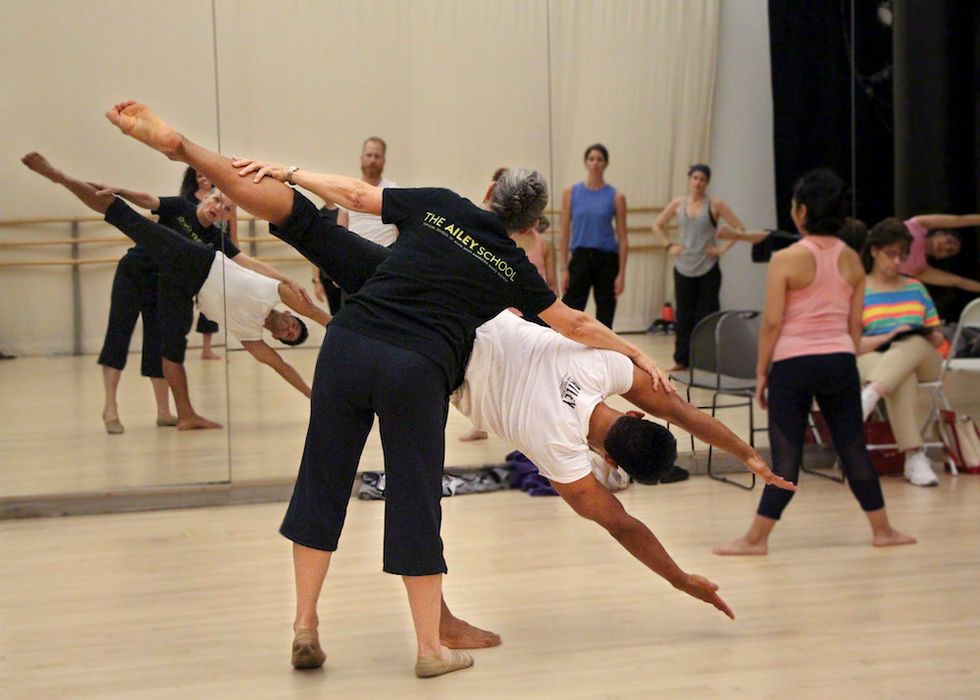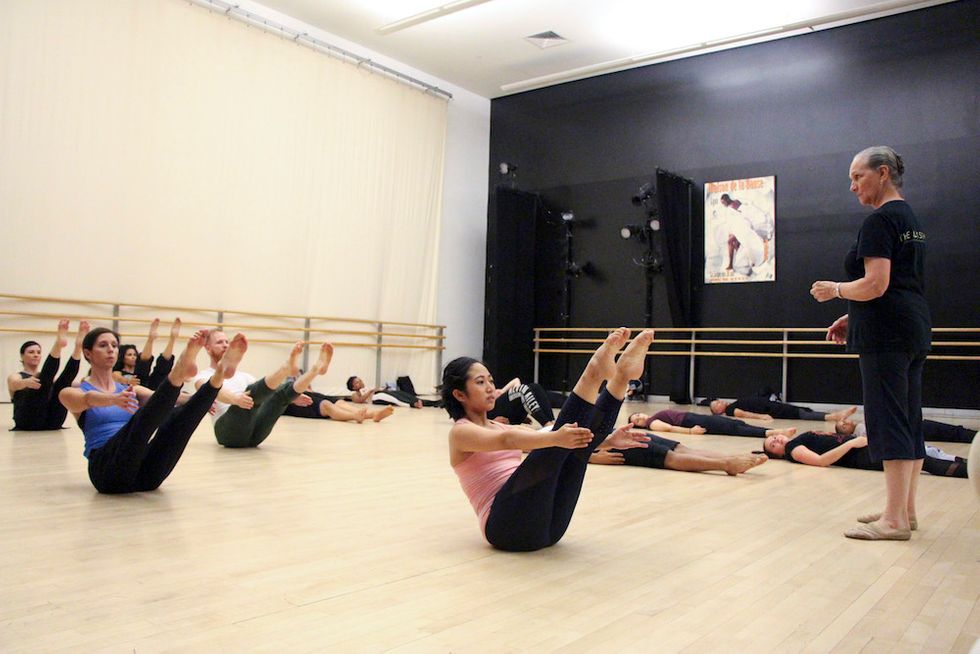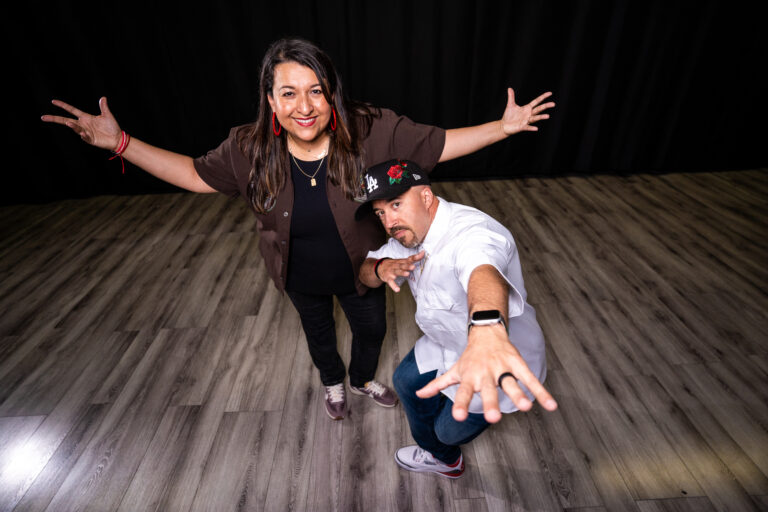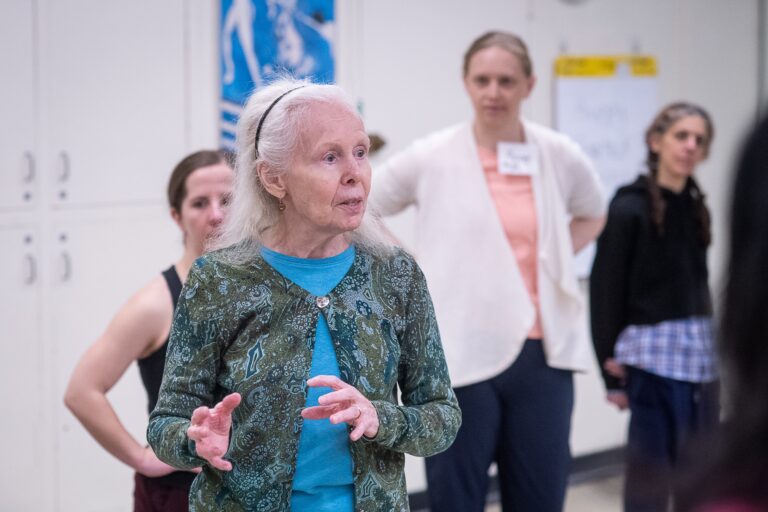
Ana Marie Forsythe’s eyes twinkle, and a smile plays at the corners of her mouth as she welcomes the 40-plus teachers who are enrolled for her two-week-long Horton teacher-training workshop at the Alvin Ailey American Dance Theater studios in New York City—plus me, a dancer and writer, taking part for the day. As we watch Genius on the Wrong Coast, a film about Lester Horton, the “princess of Horton” (as someone aptly refers to Forsythe) offers her own version of a director’s commentary: She identifies faces as they appear onscreen and interjects her own narration (“Fortification 15—that’s the one I hated so much,” she says).
The people featured in the film—Ailey, Carmen de Lavallade, Joyce Trisler—are her former teachers and mentors, the ones from whom she learned about Horton and who encouraged her to take up residence at AAADT, where she’s taught the technique since 1973, chairing the Horton department since 1979. Forsythe has more than half a century of Horton technique under her belt, and that is precisely why I am afraid: because the rest of this day is devoted to practicing the elements of Horton, a technique I have never studied.
I’ve heard about it, of course. Like any good student, I know my dance history. I know that Horton builds long and lean muscles, and I know that flat backs are a big thing, as are T shapes. But I find the technique intimidating—so many exercises, or “fortifications,” to memorize, so much terminology, so many muscles to engage. So why am I game to try it? Because anyone would be crazy to pass up the opportunity to take Horton from Forsythe, who still mines it daily for the specificity and discipline she first discovered as a young dancer. As a teacher, she transcends the demands of the technique, making it an accessible movement study, rich in detail and context.

Forsythe conducts her annual Horton training for teachers. Photo by Nicole Tintle, courtesy of The Ailey School
“There should be some atmosphere to it. Look mysterious!”
I opt to observe the first movement class of the day. This ends up being a wise decision, as the teacher-training attendees move through the fortifications they’ve learned over the three days prior at lightning speed. They pause only when someone has a question about sequence or specifics, or when Forsythe needs to troubleshoot an exercise. She’s constantly offering up tidbits of wisdom as she roves around the studio to tweak positions.
“Sometimes, you do have to adjust your position,” she says, when an attendee struggles with release swings (moving from a flat-back position on one side of the body to the other, with a dipped swing of the torso). “Just be discreet. Don’t forget—you can modify.” During figure eights, which require hip isolations as the arms stay at right angles to the body, she urges the group to give their port de bras real weight. “Like you’re resting something on your arms,” she says. “This is from a film [that Horton choreographed], White Savage—you’re coming out of the jungle, so there should be some atmosphere to it. Look mysterious!”
“Remember what the subtitle of this is?” she asks, as they prepare to complete dimensional tonus, a study that includes directional changes and long, head-to-toe stretches. “The yawn stretch!” her students respond. “That’s exactly what you should be feeling,” she reminds them. “Afterward, you should be completely toned.” She pauses, the twinkle in her eyes still present. “Dimensionally, that is.”

Horton is a fundamental of training at The Ailey School. Photo by Nicole Tintle, courtesy of The Ailey School
But Forsythe can be firm, too. When, near the end of class, she teaches an extended phrase on the right side that’s a hodgepodge of movement from the fortifications and studies they’ve just completed, she leaves the dancers to figure out the left side on their own, on the spot. “Remember,” she says, “I’ll never show you the other side. That’s your job, not mine.”
“If you aren’t physically or emotionally ready to fall, don’t.”
After a quick lunch break, it’s time to learn new material—and I’ve officially decided to be brave and join in. Like the rest of the workshop participants, I keep paper and a pen nearby to jot down notes. We begin with fortification 11, which requires moving from a seated triangle position on the floor to a squat, second-position grand plié, standing position or jump into the air—depending on what part of the fortification you’re on—in a single count. It is here that I experience my first beginner’s success; I am lucky enough to have a long Achilles tendon, which makes the shift from the ground to the next position significantly easier. I beam as Forsythe praises my transition and Achilles and feel briefly confident that I am a natural.
This reverie is quickly upended by the next two exercises, lateral and back falls. As their names suggest, they involve falling directly to the ground either sideways or backwards, in far too few counts: first four, then two. Forsythe knows the bodies before her vary widely in age and ability. “If you aren’t physically or emotionally ready to fall, don’t,” she warns. She understands the primary directive: that these men and women leave the workshop week with the knowledge needed to competently pass this technique on to their students.
By the end of class, I’m spending more and more time writing notes and less time attempting the movement. I can feel soreness already beginning to set into my quadriceps and lower back. I smell the unmistakable scent of Icy Hot, and I know I am in good company. I’ve gone on a long mental journey over the last several hours, I realize—at first, I found myself thinking there was no way I’d be able to do Horton, that I’d have to be superhuman to be successful at it. But I found myself surprised by own ability at the day’s end. I suppose that’s Forsythe’s special gift.




